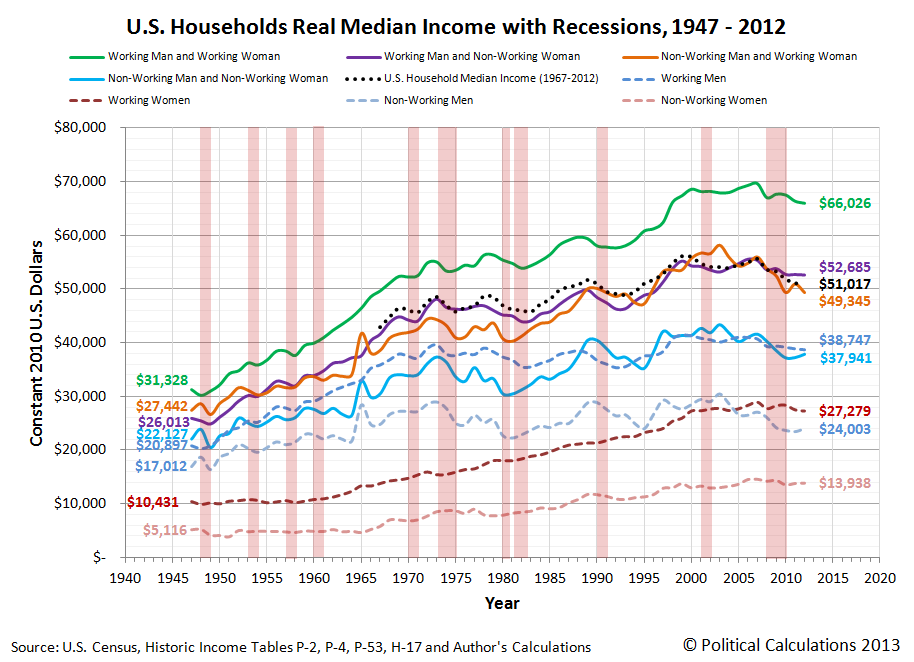January 2014 is not shaping up to be a good month for the reality-challenged belief system of the Incredibly Incurious Journalist Jonathan Chait.
Still smarting from his defeat in the debate on whether Obamacare is beyond rescue, the findings of newly published academic research into the nature of why income inequality among U.S. households and families has risen over time couldn't have come at a worst time for the leftist journalist.
The abstract of the paper gets straight to the issue at hand:
Has there been an increase in positive assortative mating? Does assortative mating contribute to household income inequality? Data from the United States Census Bureau suggests there has been a rise in assortative mating. Additionally, assortative mating affects household income inequality. In particular, if matching in 2005 between husbands and wives had been random, instead of the pattern observed in the data, then the Gini coefficient would have fallen from the observed 0.43 to 0.34, so that income inequality would be smaller. Thus, assortative mating is important for income inequality. The high level of married female labor-force participation in 2005 is important for this result.
"Assortative mating" is a term borrowed from genetics, which refers to when the members of a species select mates based on their observable characteristics, seeking mates whose characteristics are either similar to their own or that they find desirable.
Where economics and income inequality come into play is when one of the main characteristics that people use to form families and households is the income-earning potential of their prospective spouse. Our own groundbreaking analysis shows how simply combining working or non-working men and working or non-working women into various one or two-person households can create considerable disparity in the amount of income earned by each resulting household:
The data in this chart is solely based on the median income earned by each type of household member, so every individual income upon which it is based is represented by a person whose income places them in the exact middle of the income distribution for their category in the year indicated.
Now, consider the following changes in the composition of households might change as a result of this assortative mating. What would happen to the measured amount of income inequality over time if:
- Men and women who both have high income earning potential increasingly form households together, with both delivering on that potential.
- Men and women who both have low income earning potential increasingly form households together, with both delivering on that potential.
Why, that's a recipe for increasing income inequality over time, isn't it? Especially when you consider these changes would coincide with a reduction in the number of households and families that are composed of one individual with high income-earning potential and one individual with low-income earning potential.
And that doesn't even consider the situation for when a household or family either fails or if one of the income-earning members of the household passes away, leaving behind just a single income-earning household.
All of which combines to produce the following picture for the major trends in income inequality since 1947:
In this chart, we see that the measured income inequality among individual Americans hasn't meaningfully changed since 1960, while the income inequality measured in American households and families has increased. That is the telltale indication that social factors, rather than economic ones, are behind the increase in the income inequality observed for U.S. households and families.
This is the kind of real world evidence that income inequality theorists like Chait and his precious few sources in academia who share his cloistered world view disregard. Because if they accepted it, they would have to abandon the policy prescriptions that derive from their debunked claims.
But then, we're talking about someone who actually believes that Obamacare can be rescued. Even though the evidence today says that it cannot, especially considering that the whole political rationale for the program was sold on lies. Lies fully bought into by people like today's income inequality theorists.
And for the record, Jonathan Chait has still never contacted us regarding any of the original analysis we've generated here on the topic of the income distribution of Americans over the years. As journalists go, he's certainly an incredibly, unbelievably, stupendously, incurious member of the profession.
What else can we say? Vindication tastes sweet! Our long-time readers know what comes next....
Previously on Political Calculations
- How to Detect Junk Science
- Debunking Income Inequality Theory
- The Incredibly Incurious Journalism of Jonathan Chait
- The Continuing Adventures of an Incredibly Incurious Journalist
- The Major Trends in U.S. Income Inequality Since 1947
- The Discovery of the Unseen
- The Real Story Behind "Rising" U.S. Income Inequality
- Low End Income Inequality in the U.S.
Labels: income inequality
Welcome to the blogosphere's toolchest! Here, unlike other blogs dedicated to analyzing current events, we create easy-to-use, simple tools to do the math related to them so you can get in on the action too! If you would like to learn more about these tools, or if you would like to contribute ideas to develop for this blog, please e-mail us at:
ironman at politicalcalculations
Thanks in advance!
Closing values for previous trading day.
This site is primarily powered by:
CSS Validation
RSS Site Feed
JavaScript
The tools on this site are built using JavaScript. If you would like to learn more, one of the best free resources on the web is available at W3Schools.com.

